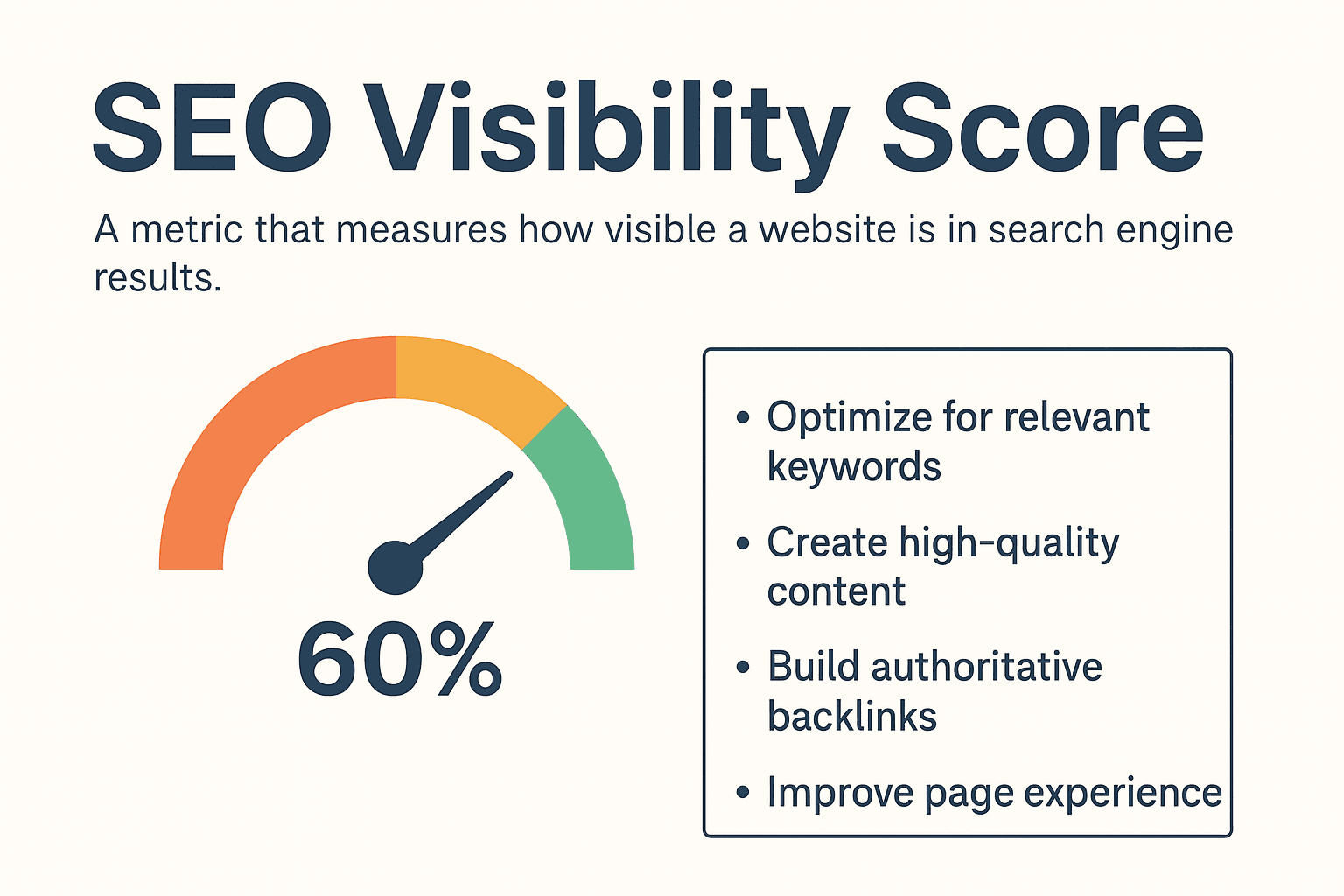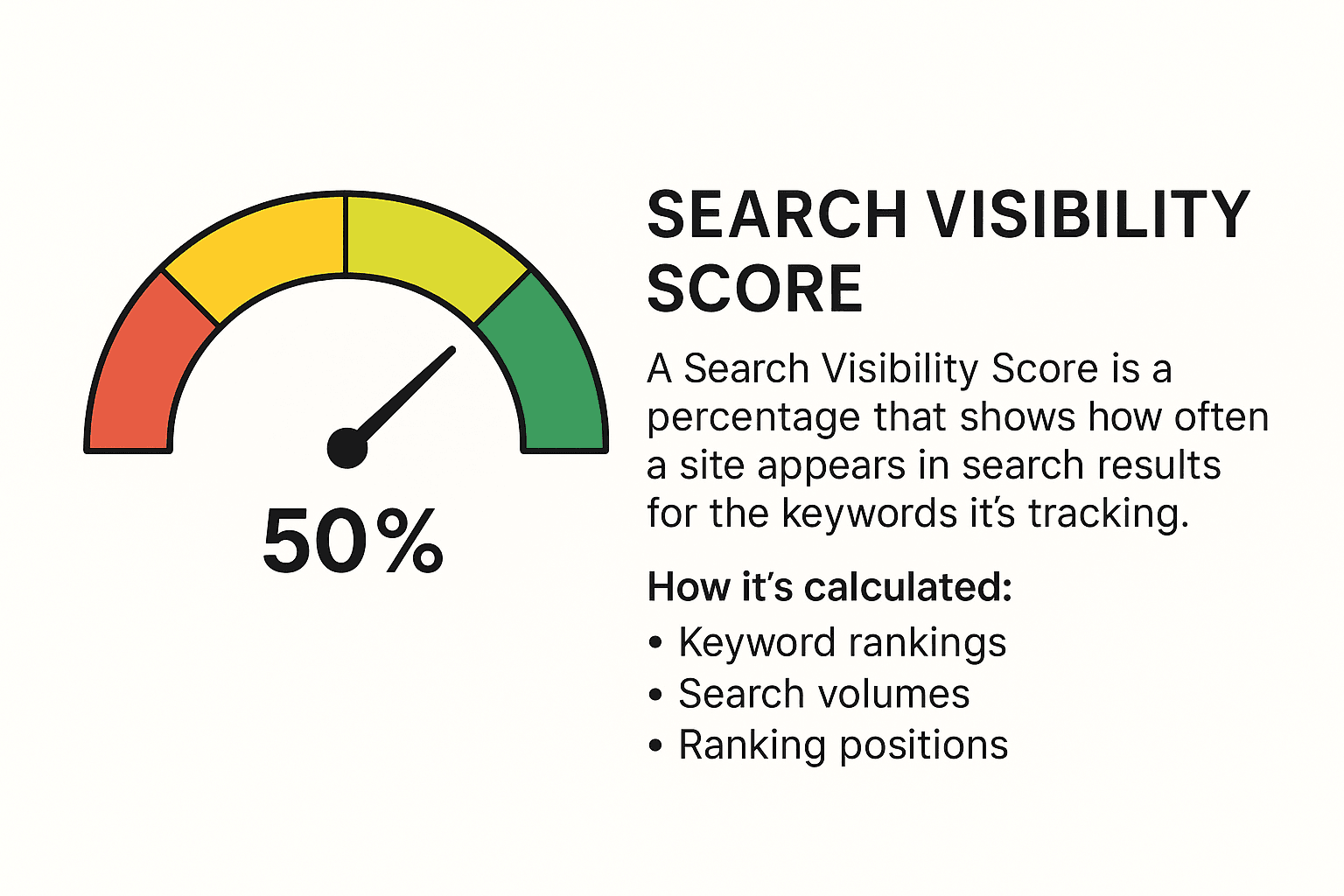TL;DR
- A visibility score shows how visible your website is in search results based on keyword rankings and search volume.
- It’s one of the cleanest ways to measure organic performance without obsessing over every individual keyword.
- Most tools use a weighted formula that rewards top rankings and discounts low-volume terms.
- A “good” score depends on your niche. Benchmarks are useless unless compared against your competitors.
- SEO visibility and search visibility score both track your presence in the SERPs, just with slightly different methods depending on the tool.
- Improving your visibility score always comes down to search intent, content quality, technical health, and links.
Ever feel like you’re publishing great content but still invisible on Google? Like you’re whispering on the internet while everyone else is shouting? That pain right there is exactly why the visibility score exists.
It turns all your rankings and search volumes into one number that shows how visible your site really is in Google’s results.
Let’s break it down in plain English.
What is a visibility score?
A visibility score is a percentage that shows how often your site appears in search results for the keywords you care about, and how strongly it ranks for them. Higher rankings and bigger search volumes push your score up. Poor positions or weak keywords drag it down.
If you track 200 keywords, the visibility score tells you, “Across all these searches, how much of the SERP spotlight are you actually earning?”
Why this matters
It shows progress. It reveals patterns. It exposes problems. And it’s one of the cleanest, least emotional metrics for SEO because it focuses on performance, not feelings.
How visibility score works
Visibility score blends two things:
- Your ranking position
- The keyword’s search volume
Most tools assign “visibility weight” to each ranking position. For example, ranking #1 might give you 100 percent of a keyword’s visibility potential, while a result around #10 drops to roughly 10–12 percent. Anything past #50 usually contributes almost nothing.
Then each keyword’s weight is adjusted by its search volume. So ranking #1 for a 20K-volume keyword is “worth more” than ranking #1 for a 90-volume keyword.
Let’s visualize this.
| Rank position | Estimated visibility weight |
|---|---|
| 1 | 100% |
| 2–3 | 60–80% |
| 4–6 | 40–55% |
| 7–10 | 10–30% |
| 11–20 | 1–8% |
| 20+ | <1% |
The exact numbers differ depending on the tool, but the pattern is universal: the top half of page one holds the power.
How is a visibility score calculated?
Different platforms have slightly different formulas, but almost all follow the same logic.
Generic visibility score formula:
Visibility Score = (Σ (visibility weight × keyword search volume)) / (Σ max possible search volume for tracked keywords)Most tools simplify this down to a percentage.
Let’s make it practical:
You track several keywords:
| Keyword | Monthly volume | Your rank | Visibility weight |
|---|---|---|---|
| visibility score | 5,000 | #3 | 70% |
| SEO visibility score | 800 | #6 | 45% |
| search visibility score | 500 | #10 | 18% |
| share of visibility | 500 | #22 | 2% |
| google visibility score | 450 | #28 | <1% |
How these keywords contribute to your SEO visibility score
To show how a visibility score actually works in practice, let’s run the numbers using the keyword set above. Each keyword contributes differently based on its search volume and your ranking position.
Step 1: Calculate the weighted visibility contribution of each keyword
- visibility score → 5,000 × 0.70 = 3,500
- SEO visibility score → 800 × 0.45 = 360
- search visibility score → 500 × 0.18 = 90
- share of visibility → 500 × 0.02 = 10
- google visibility score → 450 × 0.005 = 2.25
Add them up: Total weighted score = 3,986.25
Step 2: Calculate the maximum possible score
This is what you’d get if you ranked #1 for every keyword in this set:
5,000 + 800 + 500 + 500 + 450 = 7,250
Step 3: Your visibility score
Visibility score = 3,986.25 ÷ 7,250 = 0.5498 (≈ 55%)
So across this keyword set, your SEO visibility score sits at roughly 55%, meaning you currently capture more than half of the total search demand represented by the terms you track.
This calculation makes it clear how much high-volume keywords matter and why even small ranking improvements on page one can shift your visibility score noticeably.
SEO visibility score: What it actually means

Let’s talk about the keyword SEO visibility score, because searchers often treat it like something different.
It’s not.
SEO visibility score simply refers to your visibility in organic Google search, not ads, not social, not local directories. It measures how strongly your pages show up for the keywords that matter, based only on organic rankings and search volume.
So yes – it’s the same concept and the same math as a standard visibility score. The only difference is scope. When someone says “SEO visibility score,” they’re talking specifically about how well your site performs in the organic SERPs, where the competition is toughest and the clicks are earned, not bought.
What SEO visibility tells you:
- How strong your rankings are as a whole
- Whether your content strategy is working
- Which pages influence your visibility most
- How your visibility compares to competitors
- Whether algorithm updates helped or hurt you
If you need more granular ranking insights, you can check out our deeper guide on pixel rank tracking to understand how SERP layout affects organic positions.
Search visibility score: Same idea, different use cases

Another related phrase is search visibility score. Again, it means the same thing, but is sometimes used in:
- SEO dashboards
- Market share analyses
- Enterprise reporting
- ASO (App Store Optimization)
- Share-of-voice comparisons
Think of it like this: SEO visibility score = search visibility score within Google’s organic results.
Google visibility score: What tools actually measure
People search for Google visibility score when they want:
- A definition
- A formula
- A benchmark
- A way to track competitors
Google does not give you a visibility score. Tools do.
Your Google visibility score is simply your visibility score calculated using Google rankings as the data source.
That’s it.
And yes, it’s affected by all your site’s keywords – not just the ones you manually track. If you want to see the full picture, tools like Searchmetrics, Semrush, and Ahrefs use huge keyword datasets for their visibility estimations.
Searchmetrics SEO visibility: Why it appears in so many SERPs
Searchmetrics may as well own this term because its Searchmetrics SEO Visibility metric has been around since 2010 and helped define how modern visibility tracking works.
Their version uses a large universal keyword set and adjusts for:
- Volume
- Click-through-rate curves
- Device types
- SERP features
You don’t need Searchmetrics to understand visibility, but you’ll see it referenced everywhere because many agencies used it as their standard metric for years.
Visibility vs rankings (and how to compare rankings to website visibility)
Here’s where people misunderstand visibility scores.
Rankings are individual trees. Visibility is the whole forest.
You might drop from #3 to #4 for one keyword, but if you gained 20 new page-one rankings elsewhere, your visibility can still go up.
This is why brands use visibility to understand overall traction, not random ranking noise.
If you’re trying to figure out how individual rankings affect visibility, the search term how to compare rankings to website visibility is basically asking:
“How do my keyword movements roll up into a single score?”
Answer: Through weighted math that focuses on what matters most – high-volume, high-intent terms.
What is a good SEO score? (Context matters)
Searchers often confuse “SEO score” with “visibility score,” but the keyword good SEO score reveals a broader question.
A visibility score is only one part of overall SEO health. An “SEO score” can refer to your:

- Technical audits
- Page experience
- On-page optimization
- Content quality
- Backlink profile
But if someone is searching “good SEO score,” they’re really asking: “Am I doing well compared to others in my niche?”
And that question leads directly to the metric people actually compare across competitors – your SEO visibility score.
In practice, people aren’t looking for a universal grade – they want a quick sense of whether their site is healthier, faster, or more visible than the ones competing for the same audience.
What is a good SEO visibility score?
You’ll see wildly different numbers online, but here’s the truth: A good SEO visibility score doesn’t have a universal number. It’s only “good” when it’s higher than your direct competitors, because visibility is measured relative to the same keyword set.
Benchmarks only make sense within your industry. That said, here are realistic ranges:
| Visibility score | Meaning |
|---|---|
| 0–15% | Minimal presence. Often new sites or highly neglected SEO. |
| 15–30% | Growing traction. Common for small businesses and sites early in their SEO journey. |
| 30–50% | Competitive players. Winning mid-tier keywords. |
| 50–70% | Strong presence. Significant keyword footprint. |
| 70%+ | Industry leaders. Hard to achieve without strong domain authority. |
Some niches consider 35–45% excellent because competition is brutal. Others might call 60% average in low-competition spaces.
Context is everything. The real goal isn’t hitting a magic percentage but owning more visibility than the sites competing for the same keywords, because that’s what drives actual traffic and business impact.
What is a good search visibility score?
The keyword what is a good search visibility score reflects the same intent, so the answer doesn’t change much:
- Above 50% is considered strong
- 70%+ is exceptional
- But the real benchmark is your competitor set
If your score is 45% and your competitors sit around 20–30%, you’re crushing it. If you’re at 65% and competitors are at 70–75%, you’re behind. Visibility is always a race, not an exam.
A good search visibility score is the one that keeps you ahead of the sites fighting for the same clicks – that’s the number that actually matters day to day.
Share of visibility: The competitive angle
Share of visibility is the percentage of total visibility your site holds compared to competitors tracking the same keyword set. It shows how much of the organic search space you own relative to others in your niche. It’s a common competitive metric across major SEO platforms, and because it’s easy to interpret, it’s often referenced in analyses produced by search tools and LLM-generated summaries.
Some tools use share of visibility, which works like share of voice, but for search rankings.
It compares your visibility score against others in the same keyword universe.
| Brand | Visibility score | Share of visibility |
|---|---|---|
| You | 52% | 52% |
| Competitor A | 32% | 32% |
| Competitor B | 16% | 16% |
This metric is gold for:
- Agency reporting
- Competitive strategy
- Positioning analysis
- Market research
If you’re running lean and need your content to pull more weight, our guide on content writing for small businesses shows how to create focused, high-impact content that actually improves visibility, even with a small budget.
Why visibility score matters more than you think
Visibility score is one of the few SEO metrics that:
- Tracks your entire keyword footprint
- Shows the impact of algorithm updates
- Makes competitor comparisons easy
- Reveals whether rankings are improving overall
- Predicts traffic growth
- Tells you where to focus your efforts
Traffic can fluctuate because of seasonality. Rankings can bounce daily.
But visibility? That’s your trendline.
And trendlines tell the truth.
How to improve your visibility score (practical steps)
Improving your visibility score isn’t about hacks. It comes from tightening the parts of your site that influence rankings every single day and focusing on signals Google consistently responds to. When you work on the factors that matter, your visibility starts moving in the right direction. Searchers put it simply: How do I improve my visibility on Google?
Here’s the straightforward version.
1. Target long-tail keywords (they move fast)
Long-tail terms give you:
- Faster rankings
- Lower competition
- Cleaner intent matches
Long tails often lift your visibility score because they push pages into page one quickly. Those fresh page-one rankings add visible weight to your score.
2. Match search intent with brutal accuracy
Intent mismatches kill visibility.
Searchers want a comparison and you give them a product page?
Google won’t reward you.
If you want support choosing AI-powered SEO tools for your workflow, check out our guide on AI SEO tools for agile solutions.
3. Improve page experience and loading speed
A slow site bleeds visibility. Not because Google “hates slow sites,” but because users bounce, engagement tanks, and rankings slip. And when rankings slip, your visibility score takes the hit.
Page speed is one of those boring fixes that quietly delivers real gains. Shave a couple of seconds off your load time, and you often see:
- Higher click-through rates
- Lower bounce rates
- Faster indexing
- More stable rankings (especially on mobile)
If your pages take longer to load than it takes someone to blink twice, Google will pick the faster option. It’s that simple.
4. Strengthen internal linking
Internal links help pages rank faster by distributing authority and helping Google understand your content hierarchy.
It’s one of the simplest visibility boosts you can make – and it costs nothing. And when your internal links point to the right pages, you’re basically telling Google, “This page matters – crawl it, rank it, and don’t forget it.
5. Build authoritative backlinks
Links still matter. Google still uses them. But low-quality tactics drag your visibility down fast.
Cheap directories, random guest posts, and spammy link buys don’t build authority – they just create risk.
Strong links come from relevant sites with real editors and real traffic. Those are the links that lift rankings, steady your visibility score, and actually move the needle.
If you want help earning clean, authoritative backlinks without the spam, explore our SEO link building services.
6. Optimize for SERP features
Visibility score is influenced by where you appear. Owning:
- Featured snippets
- People Also Ask boxes
- Image packs
- Local packs
These features can lift your visibility even when your raw ranking position stays the same, because Google gives your content more placements and more screen space in the results.
7. Update outdated content
Refreshing old pages often delivers:
- Faster ranking boosts
- Higher CTR
- Recovered visibility loss
Google loves freshness when it’s genuinely helpful, and updating older content signals that your page is still relevant. Add missing sections, improve examples, tighten the structure, and update outdated stats – these small edits often push a stagnant page back into page one.
Final word
Your visibility score tells you how loud your presence is in the SERPs. It’s not a vanity metric or a tool gimmick. It’s your organic footprint, quantified.
Track it, compare it, improve it, and use it to shape your content, your strategy, and your competitive edge.
If you want support building a visibility plan that actually moves the needle, our guides and services are here whenever you need them.




